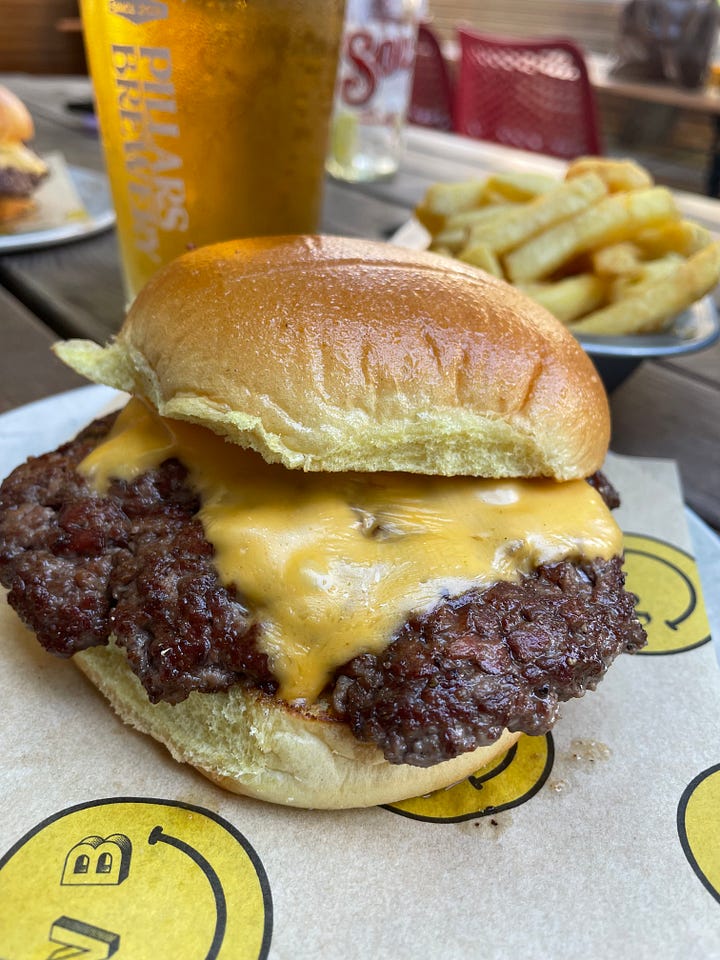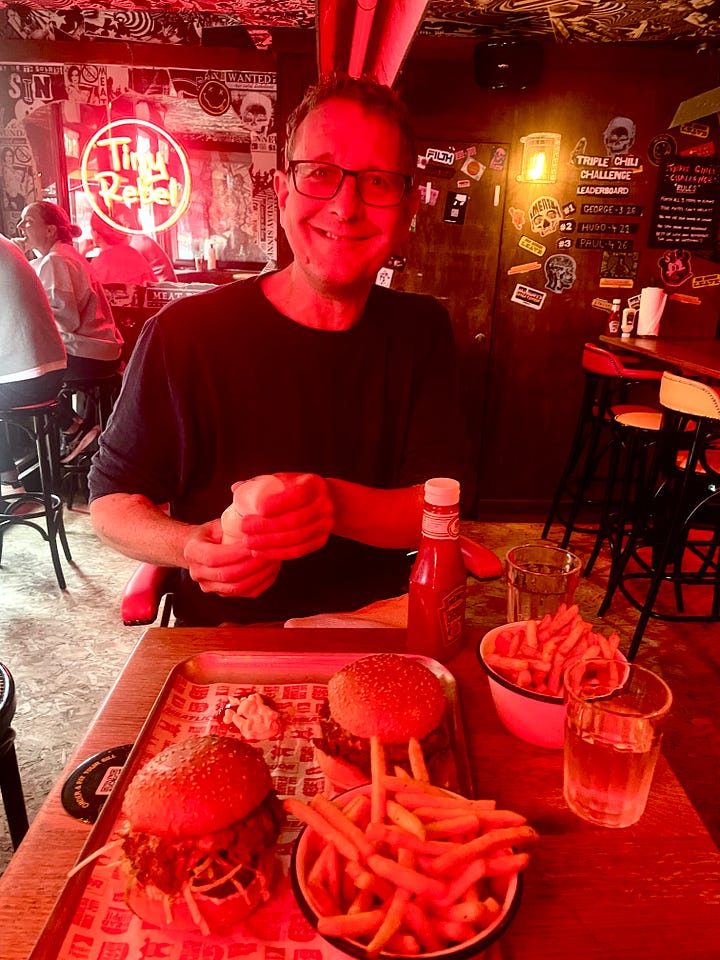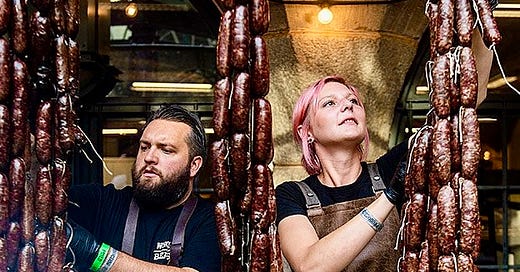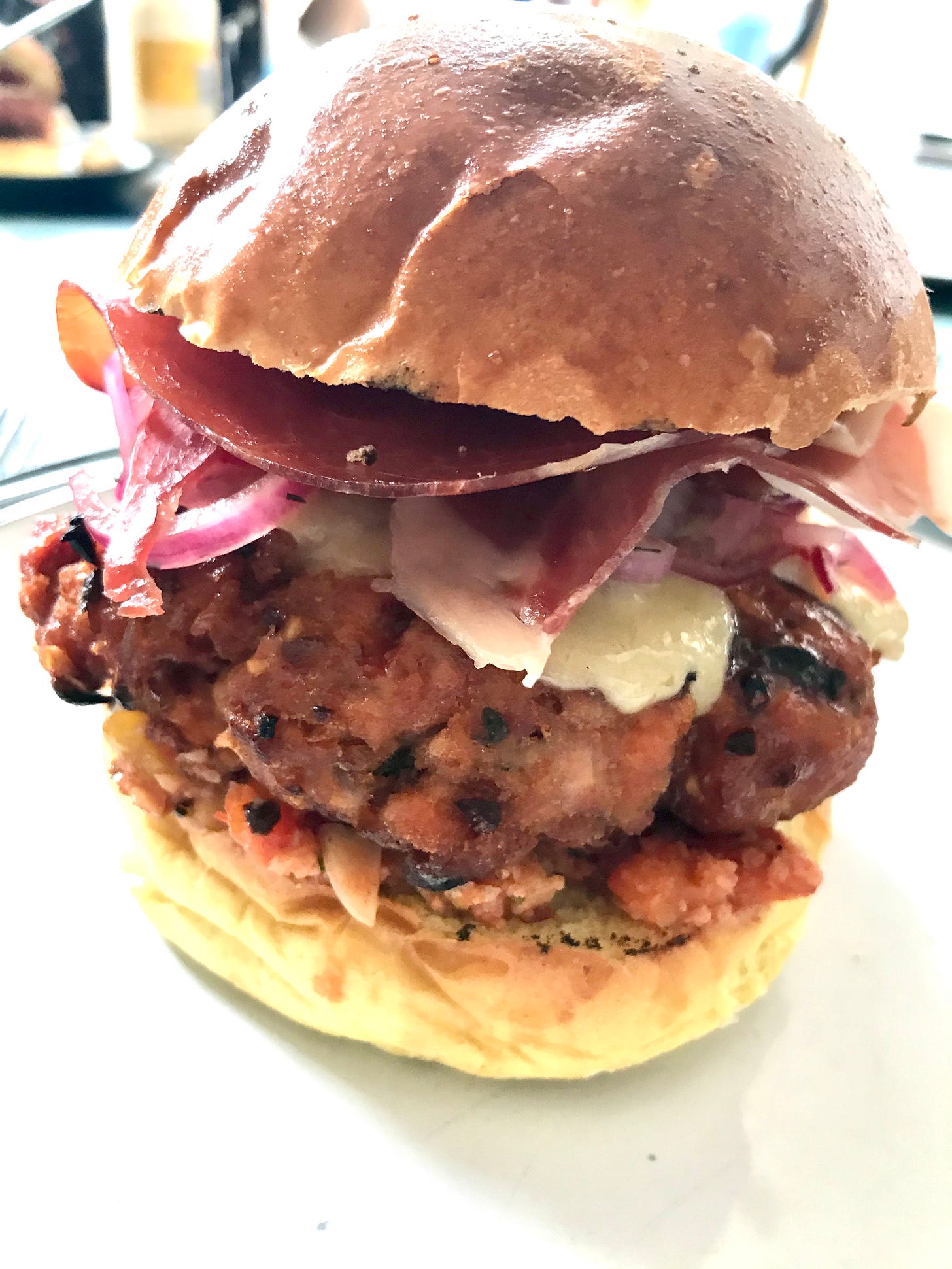In search of London's greatest burger
A Peckham pop-up has won a big national award - the latest stage in the unstoppable, half-century rise of the British hamburger. Plus: what I've been drinking recently




I suppose it’s the hamburger equivalent of Exeter City FC (insert your own modest hometown team here) winning the FA Cup. Earlier this month, Whole Beast restaurant, a pop-up currently based at a local pub, Peckham’s Montpelier, won the National Burger Awards “Champion of Champions” awards.
This pitted the winners of the last ten years of the Awards against each other: Whole Beast’s aged cheeseburger triumphed over burger luminaries including MEATliquor and Bleecker. In fact, Sam Bryant and his wife Alicja are no strangers to the London burger elite, having previously worked as heads of food at MEATliquor. But it’s still quite an achievement for a couple toiling alone in a small pub kitchen.
Needless to say, you can no longer just walk into the Montpelier and get a table. Indeed it had already got trickier getting reservations, after the Observer’s Jay Rayner reviewed the place in June (I wrote about their roasts here.) Such is the price of restaurant success in the era of digital booking systems.
But secure a reservation I did, with my friend Sarah, whose local this is. As we dug into the impressive mounds of bread and beef in front of us, I mused on the British burger’s journey through the past half century, from bastardised American import to hip culinary icon.
The first burgers in Britain were served by Wimpy, a US chain whose diner in Coventry St, London opened in 1954. Run under licence by the fusty Lyons cafe group, they looked pretty grim – and oddly British – in my 70s childhood: weird beefeater mascot, dumb slogans (“Have a weefy bimpy”) and, er, knives and forks. This was also the point when they got serious American competition with the arrival of McDonalds (1974) and Burger King (1976) in Britain. By 1988, when McDonalds opened their three-hundredth UK restaurant in Dagenham, Wimpy were in sharp decline (though incredibly, around 60 still hang on today.)
Yet while the American chains helped drive a new fast-food culture, they never elevated burgers to the kind of respectability they had long enjoyed in upmarket US grill rooms. Indeed fast food in general and burgers in particular gained notoriety for their supposed role in driving an obesity epidemic, as highlighted for the US by Eric Schlosser’s classic exposé, Fast Food Nation (2001) and Morgan Spurlock’s hair-raising documentary, Super Size Me (2004).
Burgers badly needed a makeover. Enter the “posh burger”, pioneered at the first Gourmet Burger Kitchen restaurant in 2001. Started by three New Zealanders, GBK successfully targeted more quality-conscious consumers, in places like Battersea rather than Dagenham. Byron followed in 2007 with a more classic American diner menu aimed at the same middle-class audience.
They exploited a market completely transformed in the previous three decades: today, Brits eat out on average 1.4 times a week, many times more than the relatively rare treat of the 1970s. And Byron could sell these middle-class diners a cheeseburger for £7.25, at a time when a Big Mac cost a little over £2.
Yet as I bit in my very juicy Whole Beast aged cheeseburger (£12), I was getting something else too, and not just the tasty dill-and-chilli mayo: a whiff of hipster cool. Not even GBK and Byron’s founders would have tried to claim that of their product. This was an essential ingredient of the next generation of British burgers.
The man most responsible for this turn was, improbably, an Anglo-Greek ballet production technician, Yiannis Papoutsis. He started moonlighting at his burger-focussed food truck in Peckham in 2009, with his first pop-up restaurant, MEATliquor, opening the following year in a pub owned by business partner Scott Collins.
Somehow a combination of pop-up flexibility, well-timed social media (Twitter launched in 2006 and Instagram in 2010), fine burgers and sheer swagger propelled MEATliquor to a West End site in 2011. Their irritating no-bookings policy soon saw hipsters queueing around the block to get in.
I’ll confess - I could never be bothered: I first visited MEATliquor to research this piece. I chose an “iconic” Dead Hippie burger (£12.95) while my friend Adam had the green chilli cheese burger. Considering the fuss over the closely guarded recipe for the Dead Hippie’s sauce, I was slightly underwhelmed – though it was tasty and held its structure quite well.
But back in 2011, such burgers swept all before them as the “dirty food” craze gripped London in its greasy embrace. For the next four or five years it was inescapable, with the arrival of Dirty Burger and Honest Burgers (2011), Bleecker (2012) and US chains Five Guys (2013) and Shake Shack (2014). And some were very good. I reviewed the first Honest Burgers restaurant, in Brixton Village Market, for the London Evening Standard in November 2011 and it sticks in my mind as one of the best (Stilton) cheeseburgers I’ve ever eaten.
And that’s just the burgers, never mind the many pork barbecue and chicken joints in the same vein. For this was an unashamedly Americanophile moment, and not just in its menus. It was also the first time that US-sized portions had landed on British plates. Almost as bad, no Brit had previously shown such reverence for “American cheese”, the ultra-processed apogee of the US fast-food industry.
In 2015 I tested portion-size inflation to its logical limit in an eating contest with fellow Evening Standard journalist Victoria Stewart. At Hoxton dirty-food joint Red Dog Saloon, we attempted to finish its Devastator burger (three 6oz meat patties with two slices of cheese and two rashers of bacon each, plus 200g of pulled pork) plus sides, in ten minutes. We both failed miserably.
It would be tempting to theorise that the dirty food craze choked on its own chilli-loaded fries. Yet while some nascent chains over-reached and went bust, others prospered. To expand successfully, however, they had to get in outside money and management expertise.
That inevitably changes a small restaurant chain. GBK’s founders sold it to the Clapham House Group – owner of Nandos – within four years of opening. Soon after, a former KFC and Pizza Hut senior executive took over as CEO (he’s now CEO Of Burger King UK.) The brand has changed hands several times and shed dozens of restaurants since its peak. Meanwhile Byron couldn’t ride out successive crises: having been sold to the Pizza Hut/Ask/Zizi owner with five years of founding, it then passed to private equity vultures before going bankrupt, twice.
As for Honest Burgers, just four years after its modest Brixton start, its founders sold a 50 per cent stake to a consumer-specialist private equity group. It now has 39 restaurants. Earlier this year it brought in long-time McDonalds executive Thomas Kelly as CEO and announced plans to quadruple the number of outlets by 2030.
If these businesses want to expand and make shedloads of money, this is no doubt the way to go. But in the process they risk losing their charm – even if they manage to keep burger standards high. For while you can’t disguise the quality of a substandard burger, exactly where you eat a good one makes almost as big difference to your overall sensory experience as the meat and bun.
Consider that several London burger chains were inspired by one-off joints in America. Byron founder Tom Byng says he took his inspiration from the Silver Top Diner in Providence, Rhode Island. Yiannis Papoutsis has said the best burger he ever ate was at a tiny, nondescript New England diner. Not being chains is one of the elements that make such places so engaging.
When I went to MEATliquor’s East Dulwich branch, now one of nine nationally, it was trying hard to evoke the restaurant’s gritty origins: dark, faux-American, too much neon and loud music. But there wasn’t much buzz to it. Meanwhile the original Honest Burgers in Brixton Village Market had a homespun, farmers-market charm that will be hard to reproduce.
Or as my mate Adam aphorised over his Nashville Hot Dust fries, “A good burger from a bad [scruffy] place beats a bad burger from a good place.”
Sitting outside the Montpelier on the last warm day of the autumn, a pint of craft lager by my Whole Beast cheeseburger, I felt the same. Sarah declared herself unconvinced that these are the nation’s best burgers; me, I don’t know how you’d judge definitively. But it’s clear that as well as good beef and cheese, Sam and Alicja Bryant put love into their burgers. That’s something you can’t package up and roll out nationally – thank God.
What I’ve been drinking recently
Lyrarakis “Voila” Assyrtiko 2022, PGI Crete - this producer south of Heraklion was an early pioneer of planting Greece’s greatest white grape outside its island home of Santorini. Named for the place it’s from (ie Βόιλα, not the French expression), this is bigger than most Santorini Assyrtikos, crisp, citrusy and fresh but saline and mineral too (Uncorked, Taylor’s Fine Wine, Hedley Wright and elsewhere, from £12.99.)
Yves Cuilleron “Les Candives” Syrah 2021, IGP Collines Rhodaniennes - Yves Cuilleron has made his name as one of the northern Rhône’s leading producers, somehow focussing relentlessly on quality at the same time as greatly expanding the size of his family’s holdings. He’s best know for his Condrieus, but this all-Syrah cuvée, from just outside the St Joseph appellation boundary, is as fine a northern Rhône red as you could wish at the price. Brambly, peppery, spicy red fruit, fresh yet pleasingly fleshy - and just 12 per cent alcohol (was Wine Society en primeur, £13.04 with tax; now N/A UK though Christopher Keiller still has the 2022 available in bond, £109.38/6 bottes ex-duty and VAT.)
Sandro Fay “Costa Bassa” 2020, Valtellina Superiore - outside of the famous bits of Piemonte, many little-known places in north-west Italy grow Nebbiolo, of which perhaps the most spectacular is the mountain valleys of the Valtellina. Right up against the Swiss border, the vines here climb the mountainsides in steep terraces. These reds aren’t particularly easy to find outside northern Italy (by far the most of them I’ve drunk was while skiing in the Valtellina resort of Madesimo) but they’re worth seeking out. This one offers bright, sweet berry fruit and fresh, crunchy acidity, yet it’s velvety and harmonious. Lovely (Passione Vino, £35.)





In my 1980s childhood, a birthday party at Wimpy was considered the social event of the season...
My sister and I went to Flat Iron for a casual dinner a couple of weeks ago and she had the truffle burger. Though she wasn't impressed with the amount of gherkins (erm, not sure why), she said the burger itself was thoroughly delicious.